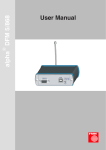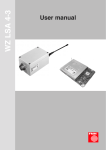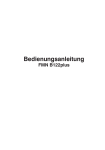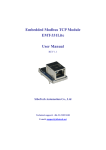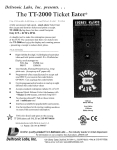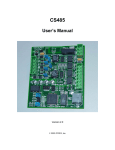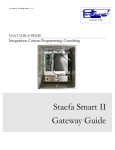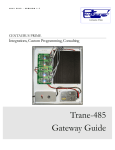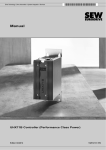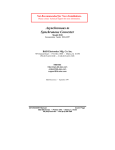Download Quick reference guide WZ FSE 2-2
Transcript
WZ FSE 2-2 Quick reference guide Radio unit for voice and data transmission in the 2 m band Safety precautions Please note! • The units are not suitable for operation in rooms with an explosive atmosphere as well as damp environments or in rooms with aggressive air or increased electromagnetic requirements. • Mind the instructions for putting into operation. • Both the casing and the antenna may become very hot (you may get burned) during sending operation. Provide for sufficient cooling and air circulation. • Installation of the antenna needs to be in accordance with the valid regulations and requirements for protection of human beings within electromagnetic fields. • Avoid to touch conductive parts of the device. • Do not open the device yourself, only permit repairs by the manufacturer. 2 ESD protection measures Comply with the ESD protection measures according to DIN EN 61340-5-1/2 when opening the unit (potential equalisation between body and ground of the unit via high-value resistance (approx. 1 MOhm) e. g. with a usual wrist band.). Information regarding the used trademarks Microsoft® and Windows® are registered trademarks of the Microsoft Corporation. All the other trademarks and product names are trademarks or registered trademarks of the relevant company. Copyright All rights reserved. Duplication of these instructions for use or parts thereof by any reproduction method whatsoever is not permitted without prior permission of the manufacturer. Amendments may be published without prior notification. Notwithstanding the above declaration, the manufacturer accepts no liability for errors in these instructions or their consequences. 3 Safety precautions Read the user manual carefully to be able to use the wealth of features of your new WZ FSE 2-2. You can find further information about this topic on our website http://www.fmncom.com. 1. General instructions • In order to be allowed to operate the radio unit you must apply for a license at your local authorities and they will assign you a frequency. • All connection cables have to be equipped with an earth-connected shielding. The connection cable for the antenna has to be equipped with a wave impedance of 50 Ω. • The manufacturer recommends to mount devices in printed circuit board version into a metal housing. • Corresponding mechanisms are to be used for the detection of single bit errors during a data transmission (e.g. protocol with creation of check sum). • Only use antenna designated for the frequency range. Failure to observe this instruction will cause the approval to expire and may result in legal action. • The connected antenna has to be tuned to the working frequency of the radio set to get a maximum range. • The use of an antenna that has not been tuned can lead to destruction of the radion unit! • Provide sufficinet cooling! (e.g. a heat energy of about 30 W has to be eliminated in case of a transmitting power of 6 W.) 4 Further troubleshooting can be necessary in case of operation e. g. at switching power supplies. • The compliance with the instructions for use and for putting into operation also belongs to the intended use. Every other use is considered to be not intended. The manufacturer accepts no liability for any damages resulting from such other use. 5 General instructions • 2. General product description 2.1 Designation of the function elements Antenna Pin20 Pin1 Pin4 User interface Pin1 Power supply Figure 2-1: Designation of the function elements 6 2.2 Interfaces of the radio unit 2.2.1 Pin assignment of the power supply The pins are assigned as follows: Pin designation at the socket 1 Voltage supply 10.8 ... 15.6 V DC 2 Ground 3 Ground 4 Voltage supply 10.8 ... 15.6 V DC Product description Assignment Table 2-1: Pin assignment of the power supply 7 2.2.2 Pin 8 Pin assignment of the user interface for analogue peripherals Assignment Function 1 STAST Input, digital 2 RSSI Output, digital 3 MOD+ Input, analogue 4 MOD- Input, analogue 5 NF+ Output, analogue 6 NF- Output, analogue 7 RS232_IN Input, digital 8 AUDIO DATA Input, digital, 9 DATA_IN Input, analogue 10 GND Input, digital 11 DATA_OUT Output, analogue Assignment Function 12 SEL0 Input, digital 13 SEL1 Input, digital, 14 SEL2 Input, digital 15 SEL3 Input, digital 16 SEL4 Input, digital 17 +5V_OUT Output 18 UET Output, digital 19 RS232_OUT Output, digital 20 ERROR Output, digital Product description Pin 9 2.2.3 Pin assignment of the user interface for digital peripherals (FFSK or GMSK modem) Pin 10 Assignment Function 1 RTS Input, digital, RS232 2 RSSI Output, analogue 3 RXD Output, digital 4 DCD Output, digital 5 TXD Input, digital 6 GND Ground 7 RS232_IN Input, digital 8 TXC Output, digital 9 BAUD0 Input, digital 10 GND Ground 11 BAUD1 Input, digital Assignment Function 12 SEL0 Input, digital 13 SEL1 Input, digital 14 SEL2 Input, digital 15 SEL3 Input, digital 16 SEL4 Input, digital 17 RXC Output, digital 18 UET Output, digital 19 RS232_OUT Output, digital 20 ERROR Output, digital Product description Pin 11 3. Putting into operation 3.1 Basic mode when the unit has been switched on see manual WZ FSE 2-2 3.2 Memory selection at the user interface see manual WZ FSE 2-2 12 4. Settings Commands Value range V Description See chapter in user manual Output of the software version 5.1.1 N ASCII 16 digits Output of the serial number of the unit 5.1.2 EX X = 0 ... 1 Echo of the commands (X = 0 -> no echo, X = 1 -> echo) 5.1.3 ?EX X = 0 ... 1 Output mode (X = 0 -> normal, X = 1 -> extended) (service command) 5.1.4 Output of all the information about the 32 memories (T, R, P) 5.1.5 Output of the information about a single memory (T, R, P) 5.1.5 M MX X = 0 ... 31 13 Puuting into operation / Settings 4.1 Software commands Commands Value range Description See chapter in user manual SMX X = 0 ... 31 Software selection: selection of the memory and the relevant TX/ RX channels and the power level 5.1.6 KX X = 0 ... 31 Setting the number of the memory (for TX, RX and PX command) 5.1.7 TX X = 0 ... 2518 Programming a new transmit channel (on the selected memory -> KX) 5.1.7 RX X = 0 ... 2518 Programming a new receive channel (on the selected memory -> KX) 5.1.7 PX X = 1 ... 5 Programming a new power level (on the selected memory -> KX) 5.1.7 ?T Output of the current TX channel number (service command) 5.1.8 ?R Output of the current RX channel number (service command) 5.1.9 14 Value range Description See chapter in user manual ?P Output of the current power level (service command) 5.1.10 ?SM Output of the number of the current memory (service command) 5.1.11 SM Hardware selection: selection of the memory and the relevant TX/ RX channels and the power level depending on the hardware setting (connection of the inputs SEL0 ... SEL4 (pins 12 ... 16)) 5.1.12 A0 Output of the analogue RSSI signal (input level) 5.1.13 Xon/Xoff - protocol: X = 0 -> switch off, X = 1 -> switch on 5.1.14 Restoring the factory preset 5.1.15 XX F X = 0 ... 1 Settings Commands Tabelle 4-1: Overview of the commands 15 4.2 Calculating the channels and frequencies Channel = Frequency [MHz] - Start frequency [MHz] + Channel offset Channel spacing [MHz] Frequency [MHz] = Start frequency [MHz] + (Channel - Channel offset)* Channel spacing [MHz] Equation 4-1: General formulas for calculation of the channels and frequencies Channel range Channel spacing Start frequency Stop frequency Channel offset WZ FSE 2-2 0000 ... 1399 0.0200 MHz 146.0100 MHz 173.9900 MHz 0 1400 ... 2518 0.0250 MHz 146.0250 MHz 173.9750 MHz 1400 137.0000 MHz 160.0000 MHz 160 165.0000 MHz 195.0000 MHz 0 WZ FSE 2-2 (HK) 0160 ... 2000 0.0125 MHz WZ FSE 2-2 (UK) 0000 ... 2400 0.0125 MHz Table 4-2: Overview of the specific parameters of the relevant unit for calculating 16 5. Troubleshooting Troubleshooting 5.1 Messages in normal output mode The WZ FSE is connected to the terminal program via serial interface. Error message Description OK Command is valid and has been executed correctly ERROR Command is valid but could not be executed correctly CMD-ERROR Command is invalid Table 5-1: Normal output mode (“?E0“) 17 5.2 Messages in extended output mode The WZ FSE is connected to the terminal program via serial interface. Message Value range Description OK Command is valid and has been correctly executed CMD-ERROR Command is invalid RX OK Programming of RX channel was successful TX OK Programming of TX channel was successful PWR OK Programming of power level was successful ERROR XX XX = 00 ... FF Command is valid but has not been correctly executed RX ERROR XX XX = 00 ... FF Error when programming the RX channel TX ERROR XX XX = 00 ... FF Error when programming the TX channel PWR ERROR XX XX = 00 ... FF Error when programming the power level Table 5-2: Extended output mode (“?E1“) 18 6. Conformity The FMN communications GmbH declares that the radio unit WZ FSE 2-2 complies with the basic requirements and the other relevant provisions of the directive 1999/5/EG (R&TTE directive). The WZ FSE 2-2 can be operated in the countries of the European Union (EU). Outside of the EU apply the national regulations of the relevant country. Conformity The complete declaration of conformity can be found and downloaded on our website http://www.fmncom.com. 19 For the sake of the environment! Waste paper content of 100 %. FMN communications GmbH Grimmelallee 4 99734 Nordhausen, Germany P.O.Box 10 04 65 99724 Nordhausen, Germany Phone: Fax: Email Internet +49 (36 31) 56-34 41 +49 (36 31) 56-32 24 [email protected] www.fmncom.com Subject to change. WZ FSE 2-2: Ka8402.0024.320.001 Edition: No. 10/06 (1112-0757)




















